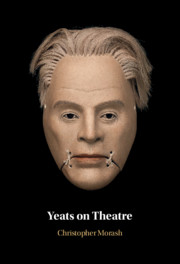Book contents
- Yeats on Theatre
- Yeats on Theatre
- Copyright page
- Contents
- Acknowledgements
- Abbreviations
- Introduction The Exact Moment
- Chapter 1 The Playwright as Thinker
- Chapter 2 The Fugitive Organum
- Chapter 3 Tragedy and Comedy
- Chapter 4 Form
- Chapter 5 Spaces and Objects
- Chapter 6 Bodies and Voices
- Chapter 7 Audiences
- Conclusion A Moment of Intense Life
- Notes
- Bibliography
- Index
Chapter 4 - Form
Published online by Cambridge University Press: 09 July 2021
- Yeats on Theatre
- Yeats on Theatre
- Copyright page
- Contents
- Acknowledgements
- Abbreviations
- Introduction The Exact Moment
- Chapter 1 The Playwright as Thinker
- Chapter 2 The Fugitive Organum
- Chapter 3 Tragedy and Comedy
- Chapter 4 Form
- Chapter 5 Spaces and Objects
- Chapter 6 Bodies and Voices
- Chapter 7 Audiences
- Conclusion A Moment of Intense Life
- Notes
- Bibliography
- Index
Summary
W. B. Yeats began work on his theory of theatre in the early 1900s in his writings for the Irish Literary Theatre and the Abbey, and these included a series of precepts for dramaturgy that encompassed character, action, and language.For Yeats, dramatic character was not simply a mimetic representation of a personality; instead, it was a set of human possibilities defined by an action.Yeats would ultimately relate this theory to his wider understanding of personality and action developed in his poetry, and in writings such as A Vision.Likewise, his theories of the language appropriate to drama, and the techniques that should be used to capture the quality of speech, are closely related to his own development as a poet.Indeed, there is an argument to be made that all of his poetry from about 1900 onwards is theatrical, in the sense that it implies a voice.Collectively, Yeats’s writings on theory constitute a coherent treatise on dramatic construction.
- Type
- Chapter
- Information
- Yeats on Theatre , pp. 93 - 112Publisher: Cambridge University PressPrint publication year: 2021

